BILQUIS-MUSHAF GENERAL HOSPITAL ELECTRIFICATION PROJECT
CONTENTS:
- Introduction.
- Overview.
- Interns.
- Problem Statements.
- Objective.
- Previous system details.
- Modified system details.
- Outcome.
- System Status Comparison.
- All modifications in the Hospital Electrification project.
INTRODUCTION:
Rashidabad Momerial Welfare Organisation is basically a welfare organisation Rashidabad Sindh, providing various free of cost facilities for the locals. Sawayra agreed to contribute in this great deed of humanity by establishing a renewable project producing electricity by solar and resulting in saving in the overall electricity bill of Bilquis Mushaf Hospital situated there in Rashidabad.
OVERVIEW:
On October 10th, 2020, the new team of full-time interns of Sawayra along with the senior interns from NED University of Technology, visited the Hospital Electrification project site to do the modifications in previously installed system.
INTERNS:
NEW INTERNS
- Muhammad Misbah
- Nazeeha Ali
- Muhammad Javed Rashid
SENIOR INTERNS
- Areebuddin Ahmed
- Khadeeja Tabassum
- Naseer Ahmed Siddiqui
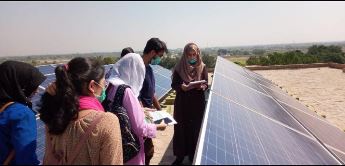
There were three more interns from another project along with two representatives from Inverex.
PROBLEM STATEMENT:
The reasons for dismantling the previous system and installing a new one are:
- The Outback system was faulty (sometimes there were issues in changeover, phase, and neutral lines and there were some other connection faults in the wiring of the hospital) and as it was a hybrid system and most of the load in the hospital was sensitive to use, so it was not using the system properly.
It means that the Outback inverter could only provide power to light loads like fans, lights, and computers, etc. - The inverter of Fronius was not being fully utilized due to an insufficient supply of solar power to the inverter resulting in inefficient operation and under the production of electricity and a 5-kW inverter is too small for a large load as this big hospital.
Some previous data showing the productions & cost saving of both previous inverters, i.e. (Fronius 5kw and Outback) is given below.
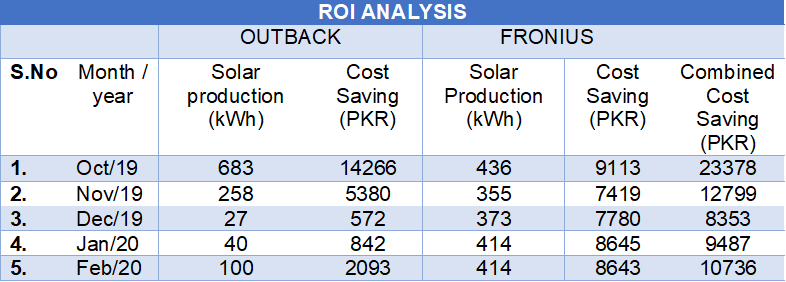
We can clearly see that both inverters give very less monthly combined saving i.e.
(AVG.12,950 PKR). And a total of 3,600,840.0 PKR was invested in installing these two systems. And the production of the outback system is not satisfactory as seen in the table above. Thus, the ROI and payback period is not very good. And as we know that by using renewable energy, we can reduce carbon emission, but here our systems were not working at their peak performance due to which we were not able to reduce carbon emission as such which would be possible if the systems were working perfectly. The detailed report of the above-mentioned information is also available at Economical and Ecological Analysis.
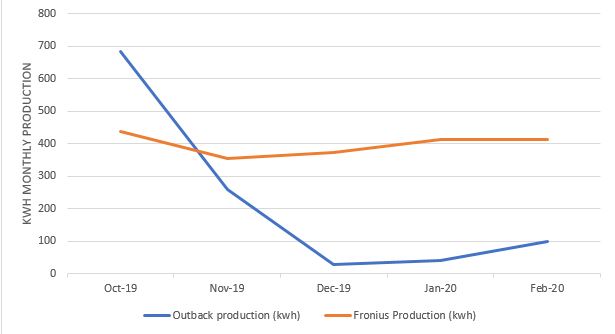
The line graph above shows the monthly production of both systems in KWh. It can be clearly seen that the production of Outback(10kW) is very disrupting and on average it is producing less electricity than 5 kW Fronius inverter. Due to the above-mentioned reasons, it was decided to remove both systems and place another 10KW grid-tie system.
PREVIOUS SYSTEM DETAILS:
The wiring diagram of the previously installed system is given below.

The wiring of solar panels for the previous system is given below.

MODIFIED SYSTEM DETAILS:
The wiring diagram of the modified system is given below:

ACCESSORIES MODIFICATIONS
- Charge controllers are removed because the outback inverter and batteries are dismantled.
- Mate 3 is also removed because it was used to access the data of the outback inverter.
- HUB 10 was removed because it was used to connect charge controllers to LAN.
- The battery bank is also removed because our new inverter is grid tie in which no batteries are needed.

PANELS DIVISION
Since we are giving 2 MPPT as the input to our newly installed Fronius grid tie inverter so we had to divide the 36 panels into two strings of 18 panels in series for each MPPT respectively. For this purpose, 12 panels of the first string and 6 panels of the second string are connected in series, likewise remaining 6 panels of second string and 12 panels of the third string are connected in series. In this way two strings, consisted of 18 panels in each string were made and they were given input to each MPPT of newly installed grid tie 10 KW inverter.
OUTCOME:
Our new inverter is working effectively with a total daily average production of 44 kWh, which is about 20% of daily consumption.

SYSTEM COMPARISON:
The description and costs of the previous inverter, batteries and the new inverter is described in the table below.
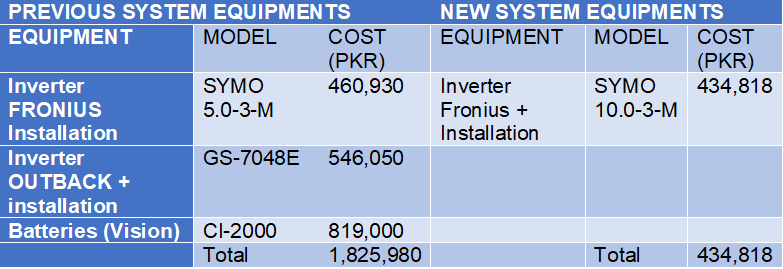
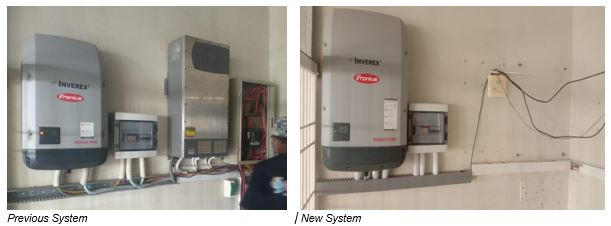
SYSTEM STATUS COMPARISON:
The newly installed 10KW grid-tie inverter is working with better efficiency than the previously installed inverters. The previously installed system was producing an average of 30KWh daily, whereas this new system is producing about 44 KWh. So overall this new system is working quite effectively. The new system provided a cost savings of approx. 25,000 PKR and the previous systems were collectively saving approx. 12,950 PKR. So, we can see that the cost-saving of the new system is twice the previous one. And as we know that renewable energy helps in decreasing carbon emission or we can say that it is similar in planting trees. The system has helped to decrease 718.7 Kg of CO2 which is equivalent to planting 18 trees, (the data is taken from solarweb). The graph below shows the average weekly production of the previous and new system. For the year 2020, the average weekly production of the previous system was 113 KWh whereas the average weekly production for the new system was more than twice, it was 260 KWh. The average weekly savings (taken 1 kwh= 20 PKR) for the previous system was 2,260 PKR and that for the new system is 5,200 PKR.
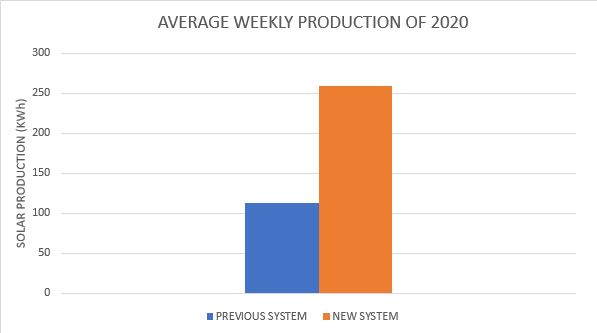
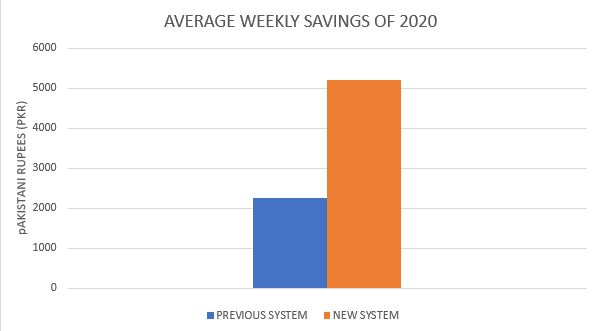
It is quite visible that the new system is offering savings of more than twice of the previous one.
ALL MODIFICATIONS IN THE PROJECT:
All modifications done till now in the project are listed below.
| PROJECT MODIFICATION 01 | Outback inverter was installed, and the third-string was left disconnected while two strings were connected to the outback inverter. |
| PROJECT MODIFICATION 02 | Fronius inverter was added to the system and connected to the third-string which was left disconnected previously. |
| PROJECT MODIFICATION 03 | AC inputs of both inverters were connected from the same source. |
| PROJECT MODIFICATION 04 | Both previously installed were replaced by another Fronius 10KW inverter and connections were made for the new inverter accordingly. |
“Instead of hazarding our future on the dirty fuels of the past, let’s invest in clean power that can drive this country forward. Let’s cut energy waste, make our economy the world’s most efficient, and give our workers a leg up in the global marketplace.”
Frances Beinecke



